File this under "Questions I hadn't thought to ask, but was fascinated to hear the answer to." In the video below, Human Computer Interaction postdoc Sarah Wiseman walks us through research done by Bell Labs more than 50 years ago.
As rotary-dial telephones were being phased out in favor of touchtone, Bell had to pick a way to place the 0-9 buttons on the new keypad of phones that would be everywhere. Turns out, there are a lot of ways to do this, and there are many reasons Bell could have chosen one design over another—cost, simplicity, speed, user preference, and so on. Their choice persists today on your cell phone, though the "calculator layout" (possibly seen on your computer keyboard if you have a ten-key digit input) has always been a partial reverse, and existed prior to Bell's new touchtone layout.
Take five minutes to learn the story here, and see some of the utterly nonsensical (to modern eyes) designs they tried out.
If you'd like to read the paper Wiseman discusses, The Internet Archive has it online for free, in a lovely, easy-to-read format. You can even download it as a PDF if you like.
Here's the citation: Bell System Technical Journal, 39: 4 July 1960 pp 995-1012. Human Factors Engineering Studies of the Design and Use of Pushbutton Telephone Sets (Deininger, R.L.).
